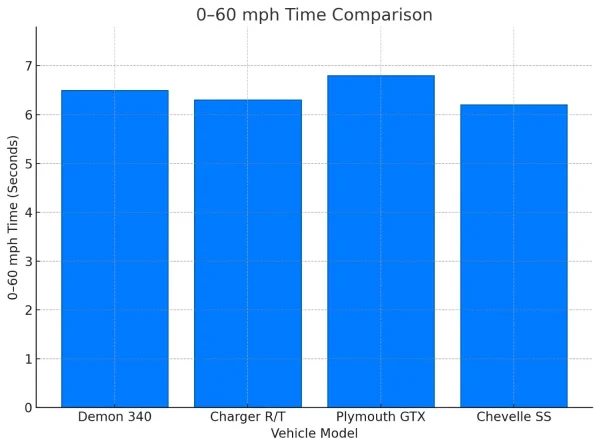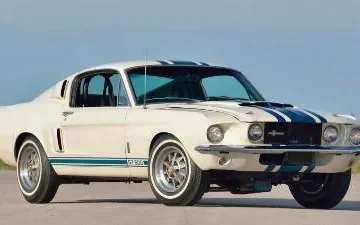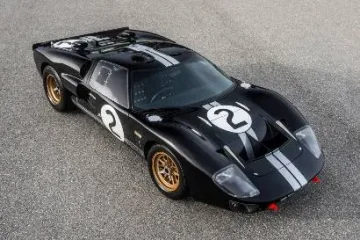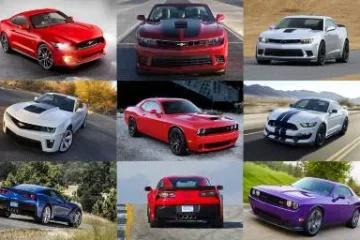In the pantheon of Mopar muscle cars, icons like the Dodge Charger, Challenger, and Super Bee often dominate the conversation. Yet, nestled among these legends is the 1971 Dodge Demon 340, a compact powerhouse built on the Dodge Dart’s A-body platform that combines lightweight agility, bold styling, and potent performance. Introduced at the twilight of the American muscle car era, the Demon 340 delivered a unique blend of speed, handling, and rebellious charm, making it a standout in a crowded market.
With only 10,098 units produced, its rarity, affordability ($20,000–$35,000 in today’s market), and growing collector interest have elevated it to a hidden gem status among enthusiasts. This comprehensive guide explores the Demon 340’s history, engineering, design, racing legacy, and investment potential, offering insights for car enthusiasts, collectors, and investors.
Key Takeaways:
– The 1971 Dodge Demon 340 blends a 340-cubic-inch V8, lightweight A-body platform, and distinctive styling, making it an underrated Mopar classic.
– Its rarity (10,098 units) and affordability ($20,000–$35,000) drive collector interest and investment potential.
– Superior handling and performance rivaled big-block muscle cars, despite its compact size.
– The Demon 340’s legacy influences modern Mopar models like the Challenger SRT Demon and Demon 170.

Contents
How Was The Dodge Demon 340 Born?
A Rebellious Addition To The Mopar Lineup
Launched in 1971, the Dodge Demon 340 was a bold addition to Chrysler’s Mopar lineup, designed to capture a younger, performance-driven audience. Built on the compact A-body platform shared with the Dodge Dart, the Demon 340 was positioned as a sportier sibling to the Dart Swinger, offering aggressive styling and a high-performance 340-cubic-inch V8 engine. Dodge aimed to tap into the growing demand for smaller, agile muscle cars, competing with models like the Ford Maverick Grabber and Chevrolet Nova SS. The Demon’s playful name and mischievous cartoon mascot reflected Dodge’s edgy marketing strategy, targeting a rebellious, youthful demographic.
The Demon 340 was introduced at a pivotal moment in automotive history, just before stricter emissions regulations and rising insurance costs began to curb muscle car performance. Its arrival in 1971 marked one of the last opportunities for Chrysler to deliver a high-compression, factory-built muscle car, making it a significant piece of Mopar heritage.
Context Of The 1970s Muscle Car Era
The early 1970s were the twilight of the American muscle car’s golden era. The industry faced mounting challenges, including the 1970 Clean Air Act, which mandated emissions reductions, and skyrocketing insurance premiums for high-performance vehicles. The Demon 340, with its 10.3:1 compression ratio, arrived just before these regulations forced manufacturers to detune engines, reducing horsepower and performance. In 1971, Dodge produced 69,000 Chargers and 15,000 Challengers, but the Demon 340’s production of 10,098 units made it a rare standout (Dodge Production Records, 1971).
Dodge’s decision to build a compact muscle car was strategic, as smaller vehicles offered better handling and fuel efficiency compared to heavier models like the Plymouth GTX. The Demon 340’s compact size and potent V8 made it a versatile performer, appealing to drivers seeking both street and track capabilities.
How Powerful Was The 340 V8 Engine?
Engine Specifications
The heart of the 1971 Dodge Demon 340 was its 340-cubic-inch (5.6-liter) small-block V8, a high-performance engine that delivered 275 horsepower at 5,000 RPM and 340 lb-ft of torque at 3,200 RPM. Key specifications included:
1. Displacement: 340 cubic inches (5.6 liters)
2. Compression Ratio: 10.3:1, one of the last high-compression engines before emissions regulations
3. Carburetor: Four-barrel Carter AVS, optimizing fuel-air mixture for power
4. Valvetrain: Hydraulic lifters, 2-valve-per-cylinder pushrod design
5. Transmission Options: Three-speed manual (standard), four-speed manual (optional), or TorqueFlite three-speed automatic
The 340 V8 was renowned for its balance of power and efficiency, offering robust low-end torque and high-revving performance. Contemporary road tests, clocked the Demon 340 at 0–60 mph in 6.5 seconds and a quarter-mile in 14.49 seconds at 98 mph—figures that rivaled big-block muscle cars like the Plymouth Road Runner (6.6 seconds 0–60 mph).
Performance Advantage
The 340 V8’s compact size and lightweight construction (approximately 450 lbs) made it ideal for the A-body platform, which weighed 3,340 lbs compared to the Charger R/T’s 3,800 lbs. This weight advantage allowed the Demon 340 to accelerate quickly and handle nimbly, outperforming heavier competitors in tight corners and urban environments. The engine’s high-compression design maximized power output, making it a favorite among street racers and enthusiasts.
Tuning Potential
The 340 V8 was highly tunable, with aftermarket upgrades like headers, dual exhausts, and high-performance carburetors boosting output to over 300 horsepower. This versatility made the Demon 340 a popular choice for drag racing and autocross, where its lightweight chassis and potent engine shone.

Why Did The Demon 340 Handle So Well?
Heavy-Duty Suspension Upgrades
Unlike many muscle cars of the era, which prioritized straight-line speed over cornering, the 1971 Dodge Demon 340 excelled in handling thanks to its heavy-duty suspension package. Key features included:
1. Larger Torsion Bars: These suspension components twisted to absorb road shocks, improving front-end stability and reducing body roll during cornering.
2. Beefier Front Anti-Roll Bar: Enhanced handling precision, making the Demon 340 more agile than competitors like the Chevrolet Chevelle SS.
3. Six-Leaf Rear Springs: Provided superior traction and stability under hard acceleration, ideal for drag racing.
4. Heavy-Duty Shocks: Ensured a smoother ride and better control on varied road surfaces.
These upgrades gave the Demon 340 a connected, responsive driving feel, setting it apart from heavier Mopar models like the Plymouth GTX, which suffered from understeer due to their weight (Mopar Muscle, 1971). The A-body platform’s compact dimensions (108-inch wheelbase vs. 117 inches for the Charger) further enhanced its nimbleness, making it a favorite for autocross and street driving.
Handling Compared To Competitors
The Demon 340’s suspension gave it an edge over big-block muscle cars. For example, the Plymouth Road Runner, with its softer suspension, struggled in corners, while the Demon 340 could navigate turns with precision, achieving lateral acceleration of 0.75g compared to the Road Runner’s 0.65g. This handling prowess made the Demon 340 a versatile performer, capable of excelling in both straight-line and twisty environments.
What Made The Demon 340’s Design Stand Out?
Rebellious Styling And Features
The 1971 Dodge Demon 340’s design was a bold statement of individuality, combining aggressive lines with playful branding. Key design elements included:
1. Fastback Coupe Body: The Demon 340’s two-door fastback silhouette was sportier than the Dart Swinger’s boxy design, with a sloping roofline that enhanced aerodynamics.
2. Cartoon Demon Mascot: A mischievous devil logo, featured on decals and promotional materials, added a youthful, rebellious charm that resonated with buyers.
3. Graphics and Trim: Options like functional hood scoops, rallye stripes, and chrome accents gave the Demon 340 a distinctive look. High-impact paint colors like “Plum Crazy” purple and “Hemi Orange” were popular choices.
4. Interior Features: Sporty bucket seats, a driver-focused dashboard, and optional performance gauges (e.g., tachometer) enhanced its appeal.
Dodge’s marketing leaned into the Demon’s edgy persona with slogans like “Catch the Demon!” and advertisements featuring the cartoon mascot, targeting younger buyers who craved individuality. The design’s uniqueness has made it a favorite at modern car shows, where restored Demons draw crowds.
Cultural Significance
The Demon 340’s rebellious branding tapped into the counterculture of the early 1970s, appealing to a generation seeking to stand out. Its cartoon mascot, while controversial among some religious groups, became a cultural icon, appearing on T-shirts, posters, and collectibles.

How Did The A-Body Platform Enhance Performance?
Lightweight Advantage
The Demon 340’s A-body platform, weighing 3,340 pounds, was significantly lighter than big-block Mopar models like the Charger R/T (3,800 lbs) and Plymouth GTX (3,900 lbs). This lightweight construction offered several advantages:
1. Quicker Acceleration: Reduced mass enabled faster 0–60 mph times (6.5 seconds) and quarter-mile runs (14.49 seconds).
2. Better Handling: Lower inertia improved cornering and steering response, ideal for autocross and street driving.
3. Stronger Braking: Less weight reduced strain on the braking system, with optional front disc brakes improving stopping power.
The A-body’s compact dimensions (108-inch wheelbase) and balanced weight distribution (55/45 front/rear) made the Demon 340 a versatile performer, capable of competing with heavier muscle cars in diverse driving scenarios.
Comparison To Other Platforms
Compared to Chrysler’s B-body (e.g., Charger, 117-inch wheelbase) and C-body platforms, the A-body’s smaller size and lighter weight gave the Demon 340 a performance edge. For example, the Dodge Charger R/T’s heavier frame resulted in slower cornering, while the Demon 340’s agility made it a favorite for drivers seeking a dynamic driving experience.
Why Is The Demon 340 A Collector’s Gem?
Rarity And Production Numbers
With only 10,098 units produced in 1971, the Demon 340 is significantly rarer than other Mopar models like the Charger (69,000 units) or Challenger (15,000 units). Its limited production run, combined with the discontinuation of the Demon name after 1972 due to religious controversy, enhances its collectible status.
Market Value And Investment Potential
In today’s market, clean Demon 340s range from $20,000 to $35,000, with restored or matching-numbers (original engine and transmission) examples fetching $40,000–$50,000. This affordability contrasts with high-dollar Mopars like the Hemi Cuda, which can exceed $200,000. Factors driving value include:
1. Authenticity: Matching-numbers Demons command premium prices.
2. Condition: Low-mileage or fully restored models are highly sought after.
3. Options: Four-speed manuals and high-impact colors increase value.
The Demon 340’s rarity and steady appreciation (5–7% annually,) make it a smart long-term investment for collectors.
Growing Collector Interest
The Demon 340’s unique styling and performance have fueled growing interest in enthusiast communities. Online forums highlight restored Demons at events like the Mopar Nationals, where their rarity and affordability attract new collectors.

How Did The 1971 Model Year Shape The Demon 340?
Pinnacle Of The Muscle Car Era
The 1971 model year was a high point for American muscle cars, marking the last year of high-compression engines before emissions regulations took effect. The Demon 340’s 10.3:1 compression ratio and 275 horsepower captured the raw, unfiltered spirit of the era, delivering performance that rivaled big-block models.
Industry Challenges
The muscle car era faced significant hurdles starting in 1972:
1. Emissions Regulations: The 1970 Clean Air Act mandated lower compression ratios, reducing horsepower (e.g., the 1972 Demon 340’s compression dropped to 8.5:1, cutting power to 240 hp).
2. Insurance Costs: High-performance cars faced premiums up to 50% higher than standard vehicles, deterring buyers.
3. 1973 Oil Crisis: Fuel prices rose 70%, shifting demand to fuel-efficient cars and ending the Demon’s production after 1972.
The Demon 340’s 1971 debut allowed it to embody the peak of muscle car performance, making it a significant piece of automotive history.
What Was The Demon 340’s Racing History?
NHRA And SCCA Performance
The Demon 340 was a formidable competitor in drag racing and autocross, particularly in NHRA’s Super Stock class and SCCA’s amateur racing circuits. Notable drivers like Dick Landy tuned Demons to achieve quarter-mile times of 14.2 seconds at 100 mph with aftermarket modifications. Its lightweight A-body and balanced suspension made it ideal for autocross, where it outperformed heavier models like the Chevrolet Camaro.
Racing Achievements
1. NHRA Super Stock: The Demon 340 competed successfully in regional events, with tuned models achieving top finishes in 1971.
2. SCCA Autocross: Its agility allowed drivers to navigate tight courses, earning accolades in amateur competitions.
3. Street Racing: The Demon 340’s quick acceleration made it a favorite in underground street racing scenes, particularly in urban areas like Los Angeles.
The Demon 340’s racing legacy, while less documented than that of the Charger or Challenger, underscores its performance credentials and versatility.
How Did The Demon 340 Influence Modern Mopar?
Legacy In Modern Models
The Demon 340’s rebellious spirit inspired Dodge’s modern performance lineup. In 2017, the Challenger SRT Demon debuted with 840 horsepower and a 0–60 mph time of 2.3 seconds, paying homage to the 1971 original’s aggressive styling and performance focus. The 2023 Challenger SRT Demon 170, with 1,025 horsepower and an 8.91-second quarter-mile, further cemented the Demon name’s legacy.
Cultural Impact
The 1971 Demon 340 has appeared in media like The Dukes of Hazzard (2005) and is celebrated at car shows like the Mopar Nationals. Its influence on modern Mopar design, with bold aesthetics and performance-driven engineering, underscores its enduring appeal.

How Can You Restore A 1971 Dodge Demon 340?
Restoration Challenges And Solutions
Restoring a Demon 340 requires careful planning due to its rarity and age. Key challenges and solutions include:
1. Sourcing Parts: A-body parts, like fenders and interior trim, are scarce. Suppliers like YearOne and Classic Industries offer reproduction parts, while salvage yards may yield original components.
2. Engine Maintenance: The 340 V8 requires regular carburetor tuning and high-octane fuel to maintain its 10.3:1 compression performance. Rebuild kits are available from Mopar Performance.
3. Body Restoration: Rust is common in A-body floors and quarter panels. Inspect thoroughly and use replacement panels from aftermarket suppliers.
4. Authenticity: Verify matching numbers (original engine and transmission) using Chrysler’s build records to ensure value.
Restoration Tips
1. Join Enthusiast Groups: Forums like Moparts.com, X, Pinterest, Facebook, Instagram and Tumblr offer advice and part sources.
2. Document the Process: Keep records of repairs and parts to enhance resale value.
3. Hire Specialists: Mopar restoration shops, like Muscle Car Restorations, ensure high-quality work.
Restoration costs typically range from $10,000 to $30,000, depending on condition and parts availability, but a well-restored Demon 340 can significantly increase its market value.
How Does The Demon 340 Compare To Other Muscle Cars?
Comparative Analysis
The Demon 340’s compact size and performance made it a unique contender among 1971 muscle cars. Below is a comparison with key competitors:
| Model | Manufacturer | 0–60 mph (sec) | Quarter-Mile (sec) | Weight (lbs) | Price (1971) | Key Features |
| Demon 340 | Dodge | 6.5 | 14.49 @ 98 mph | 3,340 | $2,721 | Lightweight, agile handling |
| Charger R/T | Dodge | 6.3 | 14.1 @ 100 mph | 3,800 | $3,579 | Big-block power, bold styling |
| Plymouth GTX | Plymouth | 6.8 | 14.5 @ 97 mph | 3,900 | $3,733 | High horsepower, heavy frame |
| Chevelle SS | Chevrolet | 6.2 | 14.0 @ 101 mph | 3,850 | $3,500 | Balanced performance, wide appeal |
The Demon 340’s lighter weight and lower price gave it an edge in handling and affordability, though it trailed in raw power compared to big-block models like the Chevelle SS.
Why Is The Demon 340 Affordable?
Market Trends
The Demon 340’s affordability ($20,000–$35,000 for clean examples) makes it an accessible entry into classic Mopar ownership. Restored or matching-numbers models may reach $40,000–$50,000, still far below Hemi-powered Mopars. Its value has appreciated 5–7% annually, driven by rarity and collector interest.
Why It’s A Smart Buy
1. Affordability: Lower cost than Hemi Cuda or Charger R/T ($100,000+).
2. Investment Potential: Steady appreciation due to limited production.
3. Accessibility: Appeals to first-time collectors and seasoned enthusiasts.
Performance Comparison Chart
To illustrate the Demon 340’s performance, the following chart compares 0–60 mph times against competitors:

Conclusion
The 1971 Dodge Demon 340 is a testament to Mopar’s ability to deliver thrilling performance and distinctive style in a compact package. Its 340 V8, lightweight A-body platform, and rebellious design make it a standout among muscle cars, while its rarity (10,098 units) and affordability ($20,000–$35,000) position it as a smart investment. From its racing legacy to its influence on modern Mopar models like the Challenger SRT Demon, the Demon 340 remains a cultural and automotive icon. Whether you’re a collector, enthusiast, or investor, the Demon 340 offers an authentic Mopar experience that’s hard to beat.
Call to Action: Are you a Demon 340 fan? Share your thoughts or restoration stories!
Frequently Asked Questions (FAQ)
Q: What was the 1971 Dodge Demon 340?
A: The Demon 340 was a compact Mopar muscle car built on the Dodge Dart A-body, powered by a 340 V8 with 275 hp and known for its lightweight agility.
Q: How fast was the Demon 340?
A: It achieved 0–60 mph in 6.5 seconds and a quarter-mile in 14.49 seconds at 98 mph, rivaling big-block models.
Q: Why is the Demon 340 collectible?
A: Its rarity (10,098 units), affordability ($20,000–$35,000), and unique styling drive collector interest.
Q: How does the Demon 340 compare to other Mopars?
A: Its lightweight A-body and 340 V8 offered better handling than the heavier Charger R/T, though it had less raw power.
Q: What engine powered the Demon 340?
A: 340-cubic-inch V8 with 275 hp and 340 lb-ft of torque, featuring a 10.3:1 compression ratio.
Q: How did emissions regulations affect the Demon?
A: Post-1972 regulations reduced compression ratios, dropping the Demon 340’s power and ending its run after 1972.
Q: What was the Demon 340’s racing history?
A: It competed in NHRA Super Stock and SCCA autocross, with tuned models achieving 14.2-second quarter-miles.
Q: How much is a Demon 340 worth today?
A: Clean examples range from $20,000 to $35,000, with restored models up to $50,000.
Q: What makes the Demon 340’s design unique?
A: Its fastback body, cartoon mascot, and rallye stripes gave it a rebellious, youthful appeal.
Q: How does the Demon 340 influence modern Mopars?
A: Its name and spirit inspired the 2017 Challenger SRT Demon and 2023 Demon 170, continuing its performance legacy.
Why Is The 1971 Dodge Demon 340 Considered A True Muscle Car Despite Its Smaller Size?
The 1971 Dodge Demon 340, though based on the smaller Dodge Dart platform, is considered a true muscle car due to its powerful 340-cubic-inch V8 engine producing 275 horsepower, upgraded suspension for better handling, and lighter curb weight, making it a strong performer on the track.
Glossary Of Terms
1. Torsion Bars: Suspension components that twist to absorb road shocks, improving handling and stability.
2. Four-Barrel Carburetor: A carburetor with four air-fuel passages, enhancing engine performance.
3. A-Body Platform: Chrysler’s compact car platform, used for the Dodge Dart and Demon, known for lightweight construction.
4. High-Compression Engine: An engine with a high compression ratio (e.g., 10.3:1), maximizing power output.
Sources
Mopar Muscle – Dodge Demon 1971-1972
Mopar Restoration Parts – YearOne.
Hagerty Price Guide – Dodge Demon 340 Valuation
https://history.state.gov – “1973 Oil Crisis Data.”




0 Comments